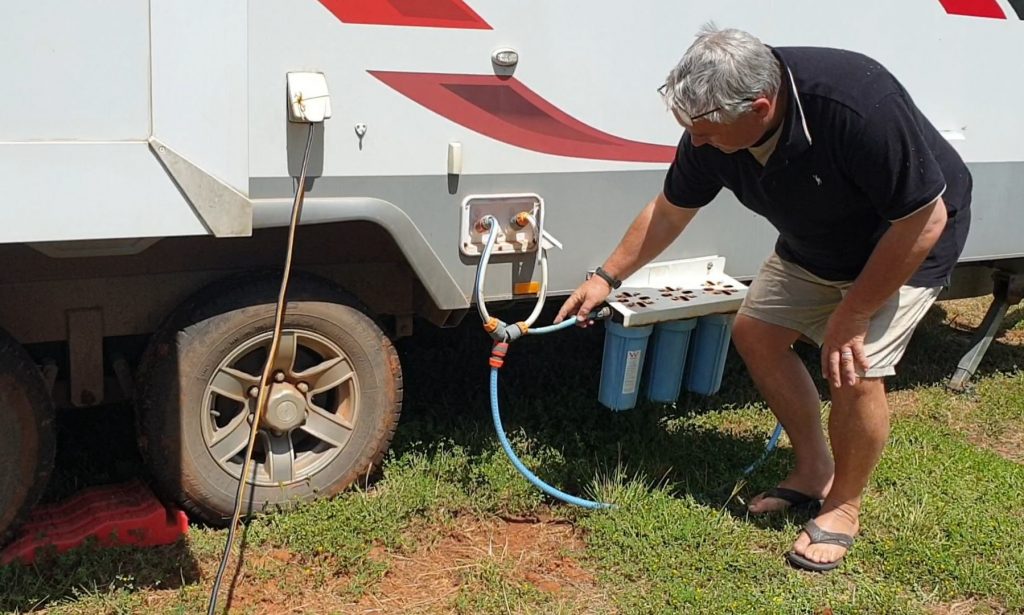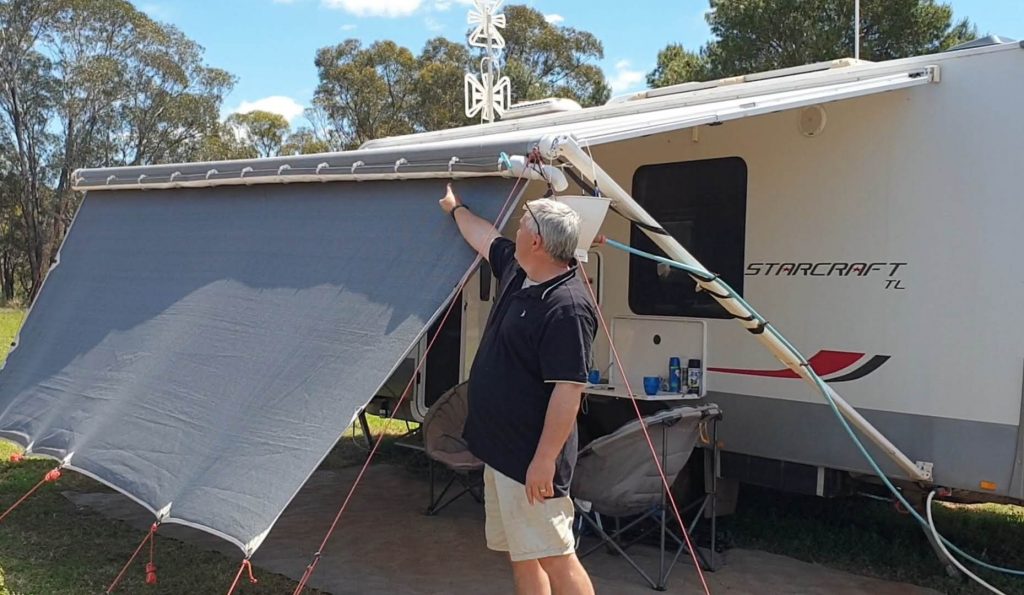Menu

 Add to favorites
Add to favoritesSometimes it’s the simple things in life that can amuse me. Rainwater catchment when free camping is one of them. At first we went with the simple and effective approach that many others do

This approach achieved the task but didn’t fall into my…… “I could automate that process” approach. Also the downside was I had to swap hoses etc over when ever I knew it was about to rain, or I had to get wet to adjust something when it was raining.

Sitting under the awning one day watching the rain pelt down I had this urge to automate the whole process. The following is what we have done to make our life during the wet days easier.
When our 6 meter by 2 meter wide awning is extended, we can capture roughly 12 litres of water for every 1mm of rain. From the awning it runs down a hose to a 40 litre rainwater tank we purchased from Outback Equipment.
From that tank, a pump draws the rain water through a strainer to our water filters then into our main water tanks. This process is all done automatically based on electronic water level sensors and some home automation software I’ve configured.

Every time we extend the awning I always set it up so that the front arm on the awning is extended fully and the rear arm is 3 notches lower than the front. This allows the water to always run towards the back of the van.

Also during setup, the valance on our carefree awning gets a dozen or so rain saver gutter clips attached to it. That way we end up with a rainwater catchment gutter system.


At the end of this gutter system we have a plastic leaf guard catcher we bought and modified from Bunnings. The leaf guard catcher is something Bunnings sell for people to use on a household roofing down pipe. To help capture leafs from the gutter rather than blocking up the pipes.

All I did was to cap off one end of the leaf guard and then fitted a hose connection to it and added some wire to hang it from the end of the awning.
I also made a gutter extension from some PVC pipe to extend the gutter so that it sits nicely over the leaf guard





I needed someway to store the rain water from the awning side of the van if our main tanks were full. Alternatively, redirect it to the other side of the van, if our main tanks needed topped up.
For that purpose we added and 40 litre tank to the rear of the van. This tank stays empty if we are travelling so as not to add additional weight to our setup. However, if we are stationary for a while then this 40 litre tank is used to store as much rain water as we can take.

The Rainwater Catchment tank got fitted with 3 electronic sensors that detect the water level without the need to drill into the tank. I also made them WIFI capable with some extra circuitry which is handy for what I’ll explain later.

This rain water tank has external level sensors that read low level, mid level and full. I also fitted a water strainer to the outlet line just as a back up. This filters out any left over items from the Rainwater Catchment, before the water heads to the pump.
In addition to the tank we have a motorised valve which I also made WIFI capable and it’s mounted to the inlet hose of the rainwater Tank.

The process now is :
I’ve always thought to myself, if we are in the middle of the outback and our water pump fails we have no backup pump. So, getting water from our main tanks would be a pain.
Therefore I bought another pump the same as our main pump which I mounted under the kitchen sink area. This pump is connected to the rainwater tank and to our main water filters.



The purpose of this pump is to send the rain water from the rainwater tank to the main tanks when required. I installed a WIFI switch, which makes this pump WiFi capable and therefore able to turn the pump on and off remotely. Additionally it’s our backup pump should the main pump ever fail.
We have our usual three filter system mounted to the side of the van. When using the rainwater system we connect a hose from the rainwater pump to the filters and from our filters to our main tanks.
That way we’ve done all we can to help maintain clean water going into our van before use.

We have two 82 litre water tanks and 1 x 82 litre grey water tank. All three tanks got fitted with the same electronic level sensors as the rain water tank did.
Only difference being, I added 4 level sensors to each tank. That being for, a quarter full, half full, 3/4 full, and full level.
Some people like watching sport, some like knitting, some like running etc, for me I like being a closet geek :). I like to play with technology and smart home devices. However, I do it on the next level to some.
I like to do my own soldering of electronic components and write my own computer programs, all of which is self taught.

Knowing that a lot of people reading this won’t want all the technical details, I will outline just the basics of what I’ve done to make the rainwater system automated.
I have a central circuit board (Called a raspberry pi) in the van that is constantly receiving data from all the sensors we have on our van which are all connected via our WIFI. It’s all configured to work offline so no internet is needed for this process.

The Raspberry Pi listens for a change in the levels of the rain water tank and based on the program I created it does the following

We don’t have to touch a thing when it rains. Other than, make sure my home automation system knows the rain water hose is connected. Accordingly it will start monitoring the levels for us.
We also have the ability to ask “Alice” ( a offline voice assistant I installed and programmed on another Raspberry PI) questions like :
All of which she will respond with the appropriate response such as “your tanks are currently half full ” or ” you have roughly 80 litres of water left”.
On a side note. I’m also making up my own display panel to replace the boring black drifter panel that currently shows our water levels. It’ll be a touch display that can control pumps and show tank levels , battery levels etc. This is it from my computer, just got to add it to a separate LCD touch display now.

As I say, some people like to watch sports etc, for me I like to play with technical stuff. To most, this is probably over the top and are quite happy to collect water in a bucket… If you are, try the RSG Accessories Rain Saver Gutter Kit

Nothing wrong with that Rainwater Catchment either, however this is how I wanted to do things “cause I can” …. “so I did ” 🙂 and it’s also how I like to entertain myself during those quiet periods of our travels. Keeps the brain active 🙂

This setup has been super handy in the last year. Not because of rain events but because of the farms we have been working on all have rainwater tanks that we usually connect to. Connecting the farmers low pressure rainwater tank to our rainwater tank allows our system to constantly keep the main tanks topped up, without having to manually turn things on and off.
When your washing work clothes constantly and showering every day its been real handy for us.
Back when we worked on the cattle station in WA. Each week we had to fill 20 litre containers of water from across the station and manually fill the tanks. That was about 8 x 20 litre containers worth of water. Never again I say 🙂
Free accommodation as you travel with Aussie House sitters See more & use our discount Coupon Code “AHS15%off”
Head to Adventure Awaits for maps, camping and fun stuff

Prices stated in blog post are correct at time of publishing and will not be updated unless re verified
Pages may contain affiliated links
The information provided by us is for general informational purposes only. Use common sense or see a professional.